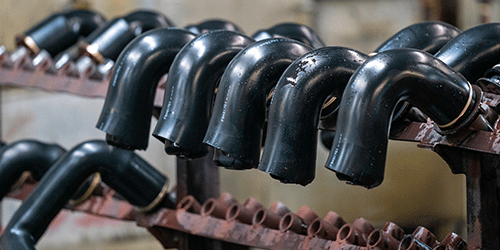Sometimes in products, or in industrial applications, vibration is an issue that requires a solution. In our business, we create solutions called vibration damping, and we do it with extruded rubber components.
In fact, when vibration is an issue, the right rubber formulation can make all the difference. But first, let’s get back to basics. What is vibration?
Vibration is a mechanical occurrence where shaking or oscillations occur due to imbalances in a rotating part (like a motor) or uneven friction. If vibration isn’t controlled, it can cause damage to the entire assembly or unit, specific parts, or even worse, fail and cause damage far beyond a part failure. To prevent any of these bad things from happening, you need vibration damping materials and components.
Vibration damping uses materials, often rubber, to absorb vibrations caused by machinery or moving parts. It
can take the form of rubber vibration mounts, pads, washers, isolators, or gaskets, and can be made with a variety of rubber compounds, but are commonly made of natural rubber, EPDM, neoprene, and butyl rubber.
We’ll cover these materials one by one, but first, a few qualities that vibration dampeners require: adhesion to substrates, durometer, and resistance to other substances (ie, chemicals, oils, heat). Which material you choose for your vibration damping needs will depend on your application, and it’s important to know how different rubber compounds perform under different conditions.
No material can deaden vibrations if it doesn’t adhere to your parts or components. If a rubber doesn’t adhere well to your substrates, it will fall off and render the damping useless.
Making sure the rubber used in your damping components isn’t too hard or too soft is crucial. Too hard and you may lose damping ability; too soft and your part may tear and fall off. It’s important to test different formulations to determine the exact right durometer for your project.
Considering the environment in which your rubber components will be used is extremely important. Vibration dampeners need to survive and lead a productive life, so understanding what elements the rubber will be exposed to is crucial. Temperature, oils, chemicals, weather, etc., can wear down parts and cause failure so it’s vital to understand rubbers’ interactions with its environment.
There are a few different vibration damping rubber materials used in most applications:
Natural rubber is a good vibration damping material that features high tensile strength, but its main drawback is that it doesn’t hold up well outdoors or in conditions that feature oils, due to its poor oil resistance.
EPDM is a synthetic rubber that features high resistance to heat and weather and features excelled substrate adhesion and durometer. It can also be formulated in numerous different compounds for many different applications.
Neoprene excels in two specific areas for vibration damping: its superior adhesion to substrates, and its resistance to oil. Neoprene is a bit more expensive than other rubbers but its ability to stick to substrates (especially metal) and its ability to perform in oily conditions makes it a great damping option.
Butyl rubber is a synthetic rubber that features low gas and moisture permeability and is extremely resistant to heat, abrasion, and tearing, which makes it an excellent option for damping vibrations.
As you can see, vibration damping parts and components can be made with a variety of rubbers, but it is crucial to find the best performing and most cost-effective option for your project. But that can be difficult unless you are a rubber expert. Fortunately, Sperry & Rice has a trained team of engineers experienced in all rubber formulations to help you determine which is right for your next project.
Sperry & Rice offers innovative engineering, advanced manufacturing processes, and comprehensive quality controls to produce precision extruded synthetic rubber components for the HVAC, automotive, transportation, and appliance industries. Our reputation lies in making sure that the rubber we provide makes the finished products of our clients reliable, and of the highest quality.
For more information about rubber vibration damping, contact us!
